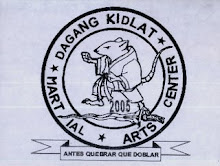(Disclaimer: This article was taken from "Rapid Journal Vol. 7 No. 4" written by Perry Gil S. Mallari. One of the few articles of this magazine that I found enlightening. The written ideas are not my own but belongs to the author. I want to post this article and share to everyone its content. Enjoy reading!)
The great japanese swordsman Miyamoto Musashi was said to have fought undefeated for seventeen years (he killed his first opponent at the age of thirteen) without really knowing exactly the secret of his success. One of his recorded contemplations say: "I reflected on my experiences, I realized that I had not been victorious because of consummate attainment of the martial arts. Perhaps it was because I had an inherent skill for the science and had not deviated from natural principles. It may also have been due to the shortcomings in the martial arts of other schools. In any case, I subsequently practiced day and night in order to attain an even deeper principle, and spontaneously came upon the science of martial arts". Musashi's investigation of the truth in combat was recorded in his treatise entitled Go Rin No Sho or The Book Of Five Rings. Go Rin No Sho is not a technical manual but rather a concept book. So universal is its conceptual content that until today men and women outside the realm of the martial arts are using it in their quest for success.
It's always easier to absorb and actualize the technical rather than conceptual aspects of the martial arts. In the former, more often than not, all you have to do is follow the instructor's commands to the letter and you'll get there (keep your hands on the centerline... distribute your weight eually on both feet... etc.) . The latter calls for a deeper degree of internalization and creativity. To make my point clear, let's use the concept of timing as an example. Even if an instructor has a perfect grasp of the concept, it doesn't necessarily mean that his student can meet him at that level and digest what's been taught. The abstract nature of the conceptual approach to training and teaching is perhaps the method's greatest strength and at the same time its greatest weakness. This is the reason why despite of its power and potency, Bruce Lee's Jeet Kune Do was still an enigma to the majority.
The proper way of doing things is absolutely important; hence there were techniques. But to transcend technique and go beyod technical proficiency, the martial artist must traverse the realm of conceptual training. Bruce had become a phenomenal martial artist because he realized this truth. According to Danny Inosanto, Bruce felt that the highest art was body feel and body mechanics not technique. I clearly saw this concept through the teaching method of one of my teachers, an 86 year old Visayan escrimador whose incredible strength and vitality despite his old age astounded me. I'm not quite sure whether because he knew of my my previous martial arts training, language barrier or lack of verbal communication skill, but he didn't teach me wih the usual "this is angle one... this is angle two..." but rather by demonstrating combative concepte. This single thing that really sank in me during my training sessions with him is the use of explosive forward pressure through multiple hits. Each contact of the weapon on the surfaces serves as a springboard to launch an attack on another plane. This is a universal concept and is the same principle behind Wing Chun's straight blast or Jik Chung Choie.
In the last two decades there is a sudden upsurge of the popularity of knife fighting not only as an art by itself but also as a training tool to develop key attribute. Practitioners, from kickboxer to devotees of esoteric fighting systems are reading benefits from poicking up the blade. Why is that so? Because knife training teaches key combative concepts like reflex, sensitivity, killer instinct, and more by combining the elements of weaponry and empty hands in a singular training environment.
Entering the conceptual path will also prod you to search combative truths beyond the ring and the mat. Not all martial arts wisdom can be attained with your bare knuckles, sticks, and blades. The Samurai warriors can explain the finer points of their martial arts through calligraphy. "Become acquainted with every art," admonishes Miyamoto Musashi. Coming from the great Japanese swordsman himself, it is comforting to know that pusuing other avenues of learning will not make a martial artist a lesser warrior but instead refine his martial growth more. Musashi Miyamoto later in his life pursued the life of a painter and writer. His works display a subtle sense of sensitivity and humility. You can hardly trace the shadow of a warrior who once a thirteen year old in his first duel, beat his opponent repeatedly with a bo until he vomited blood and die.
Monday, September 15, 2008
Subscribe to:
Post Comments (Atom)


No comments:
Post a Comment